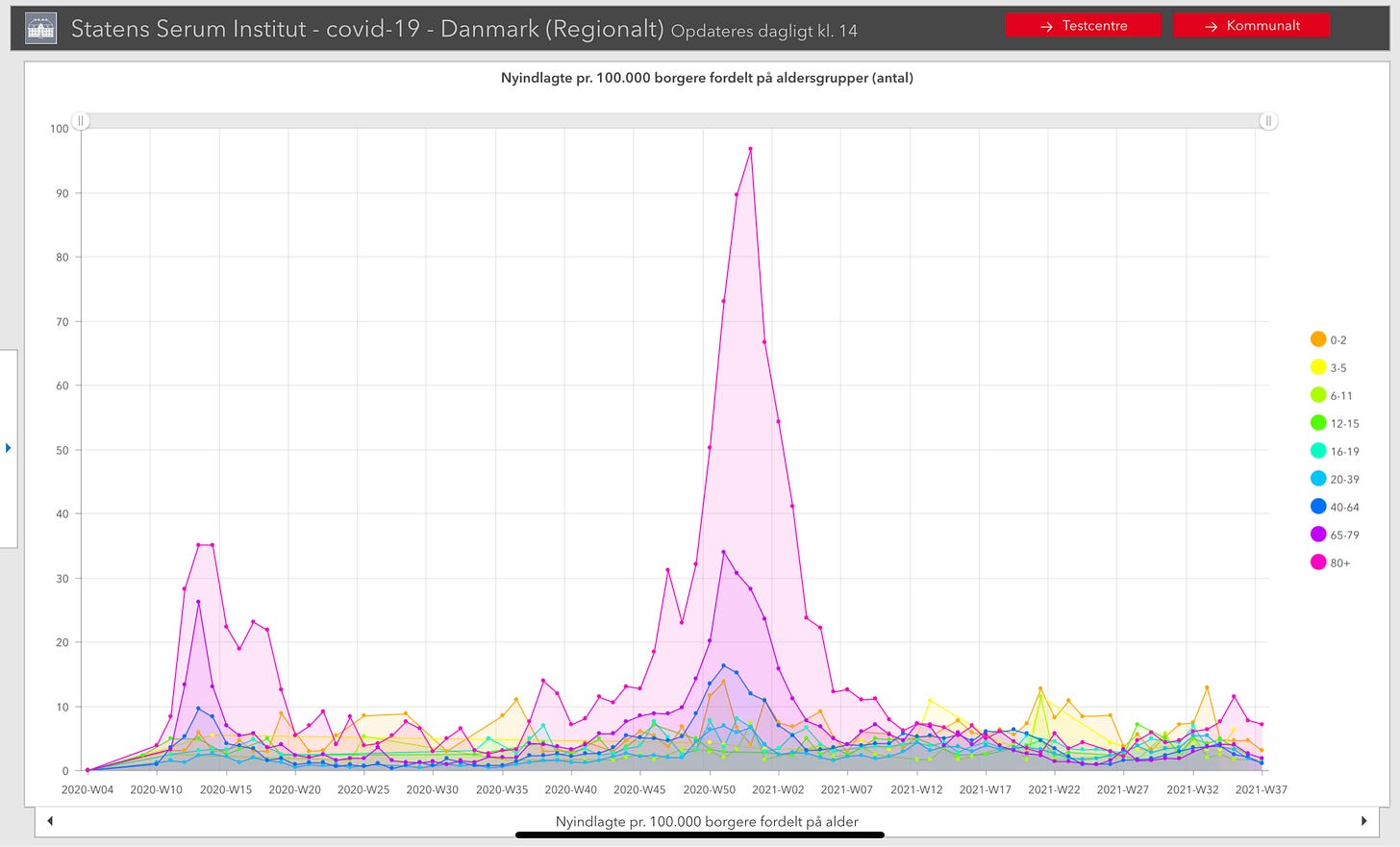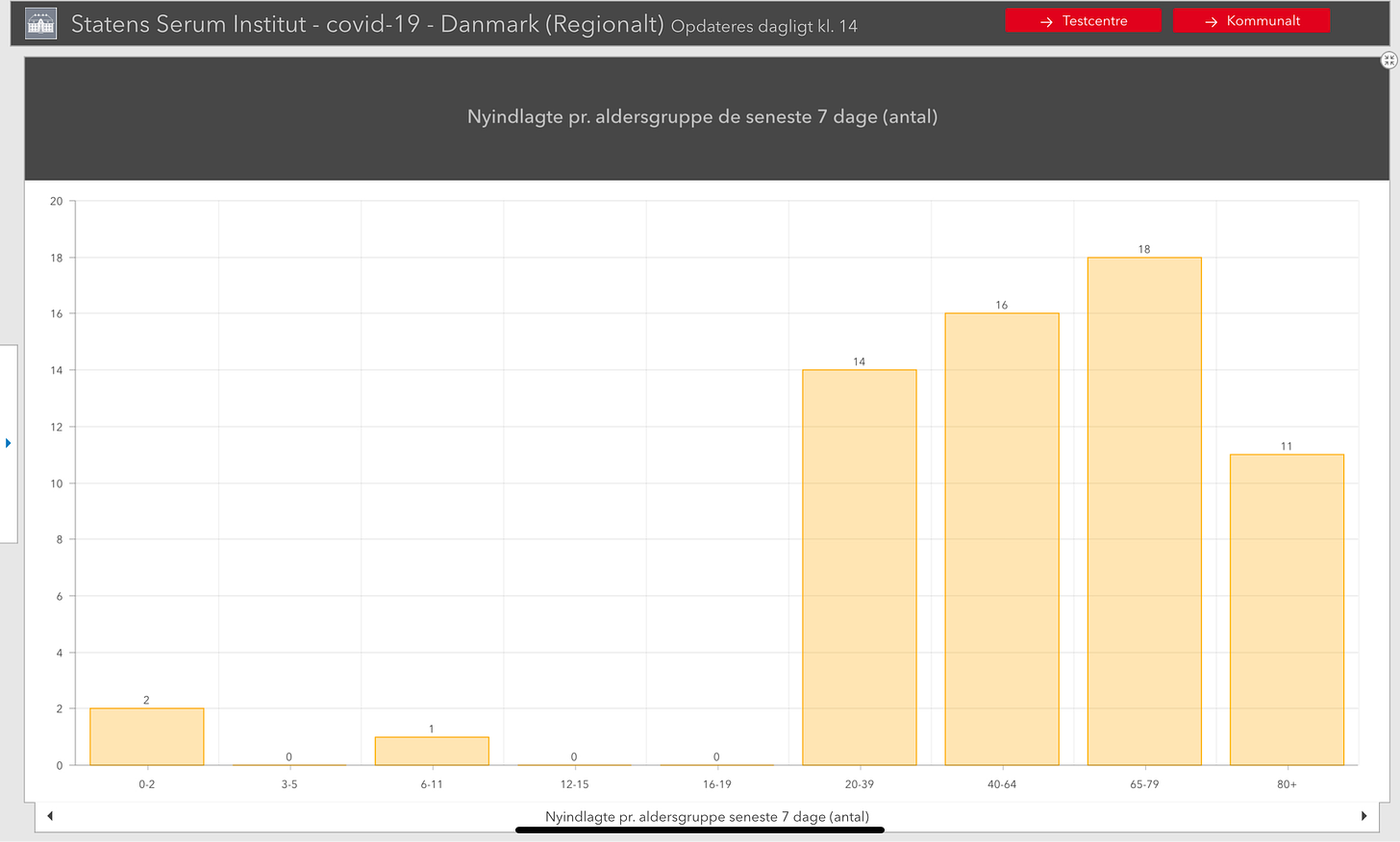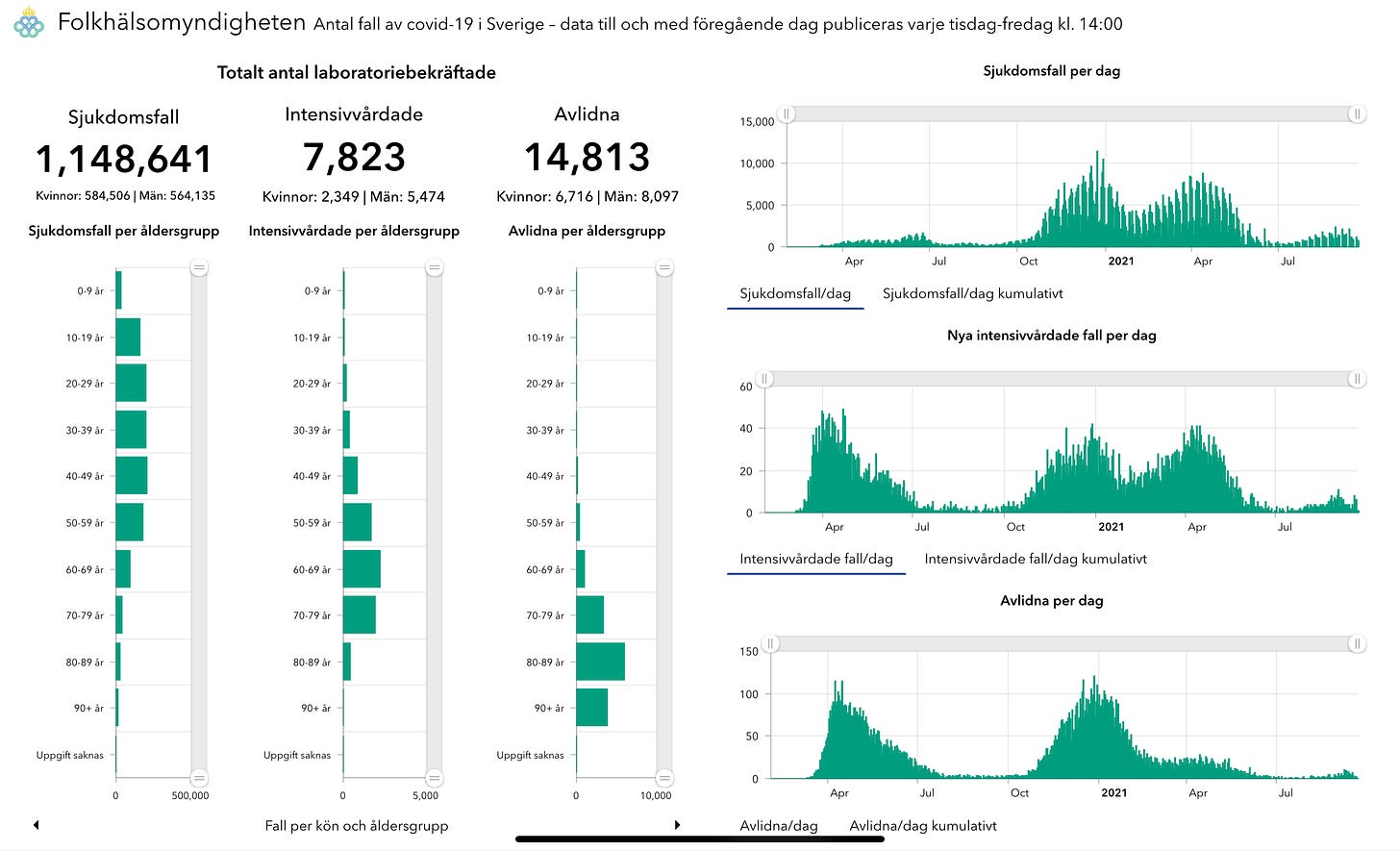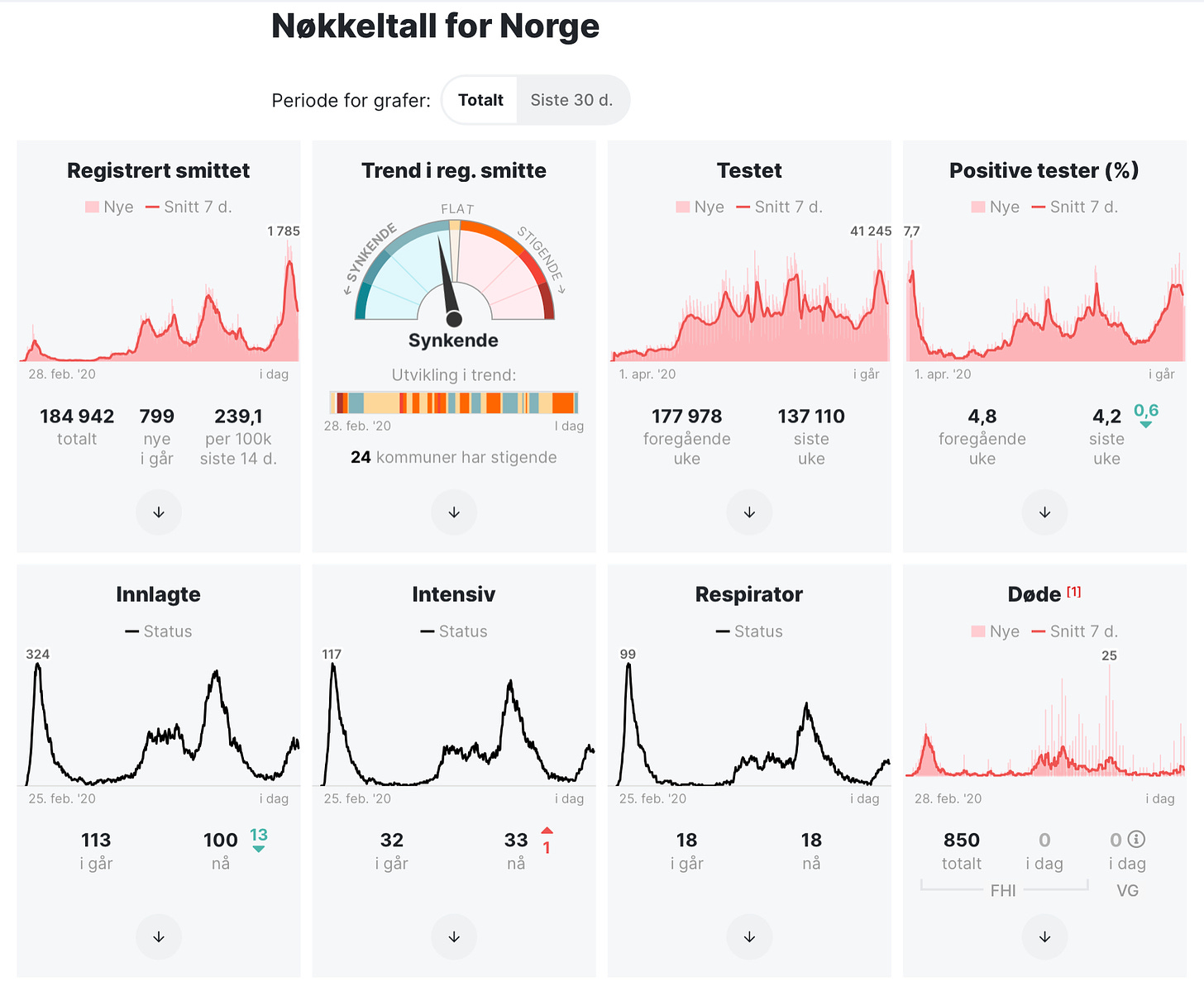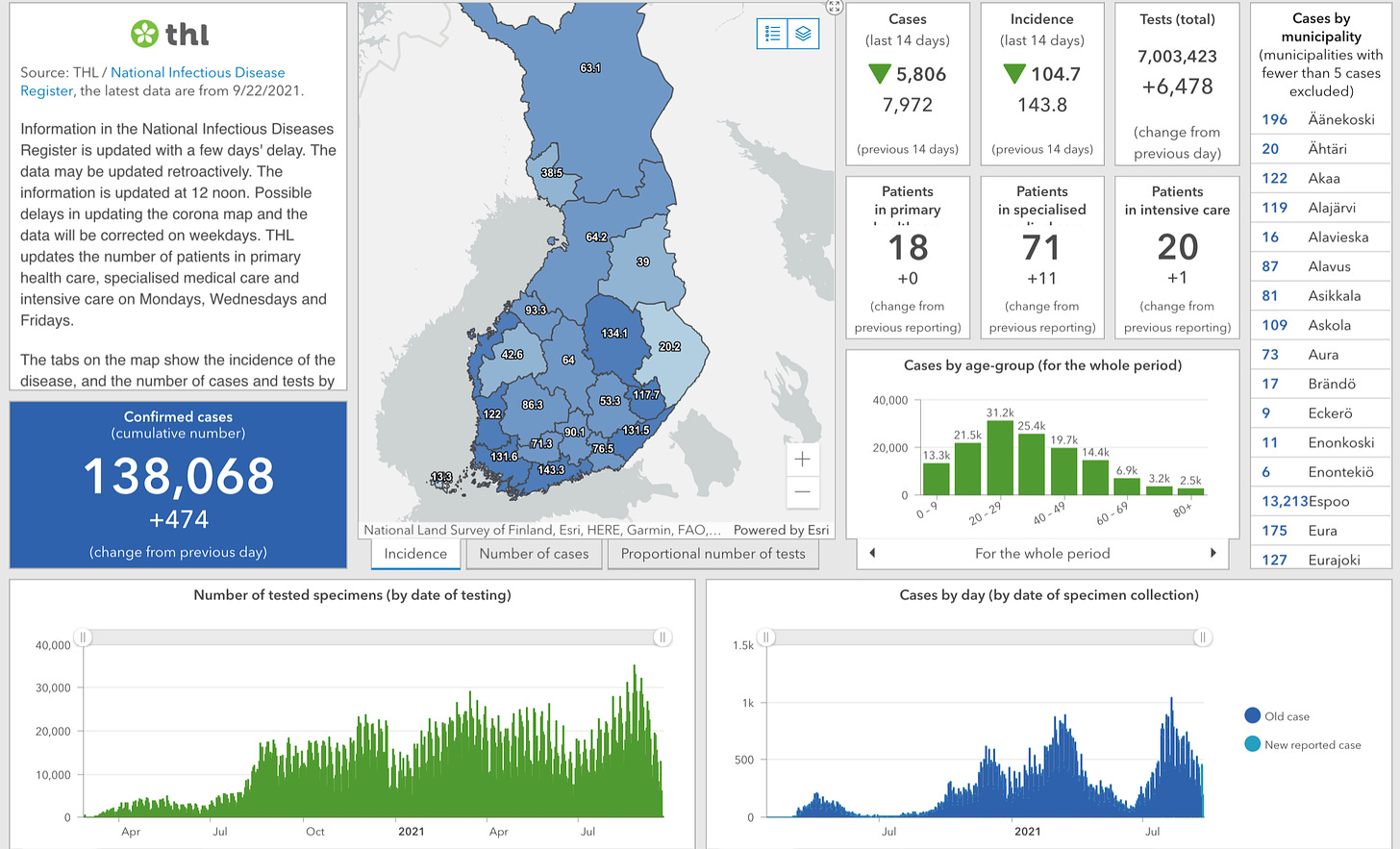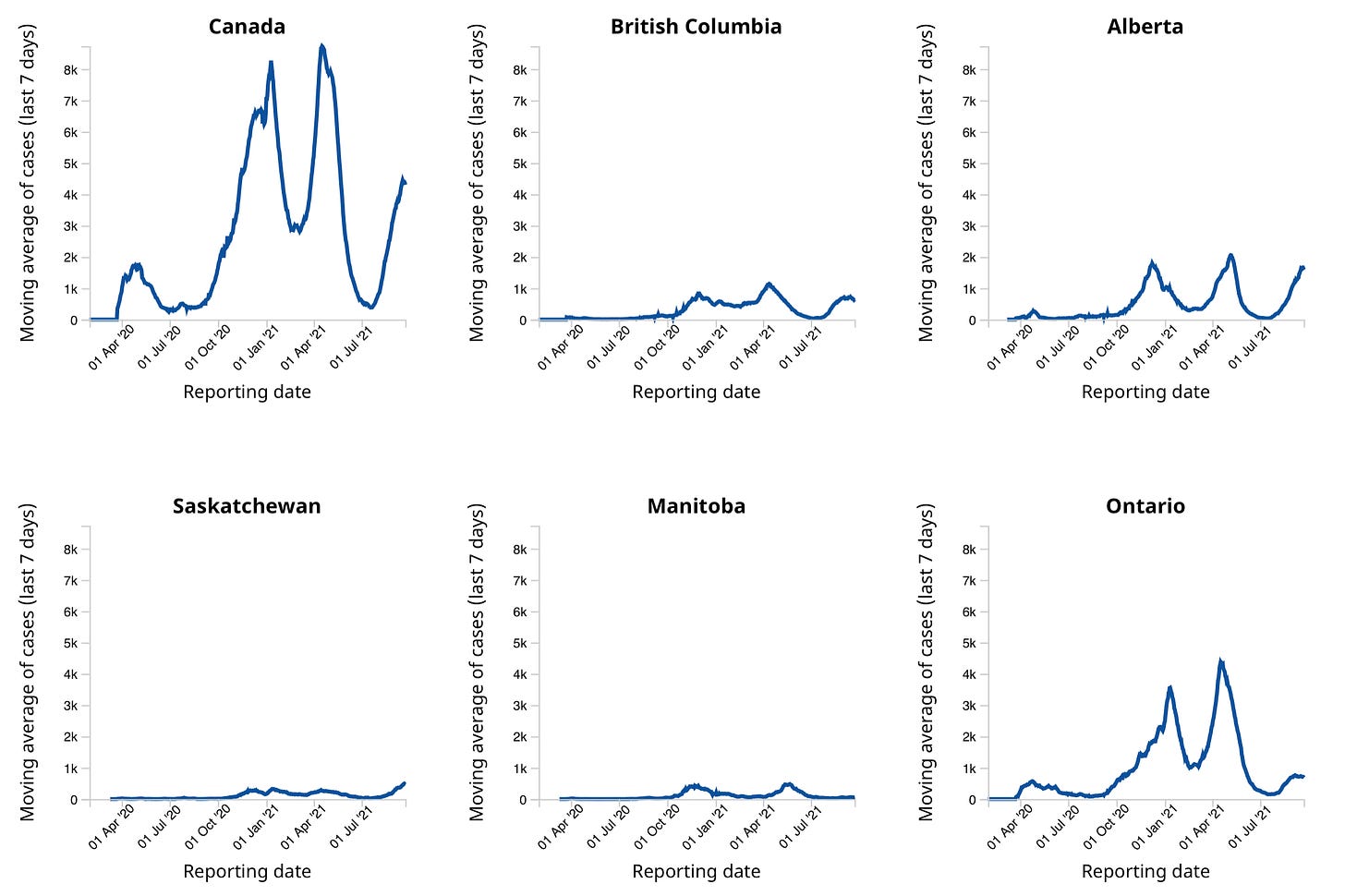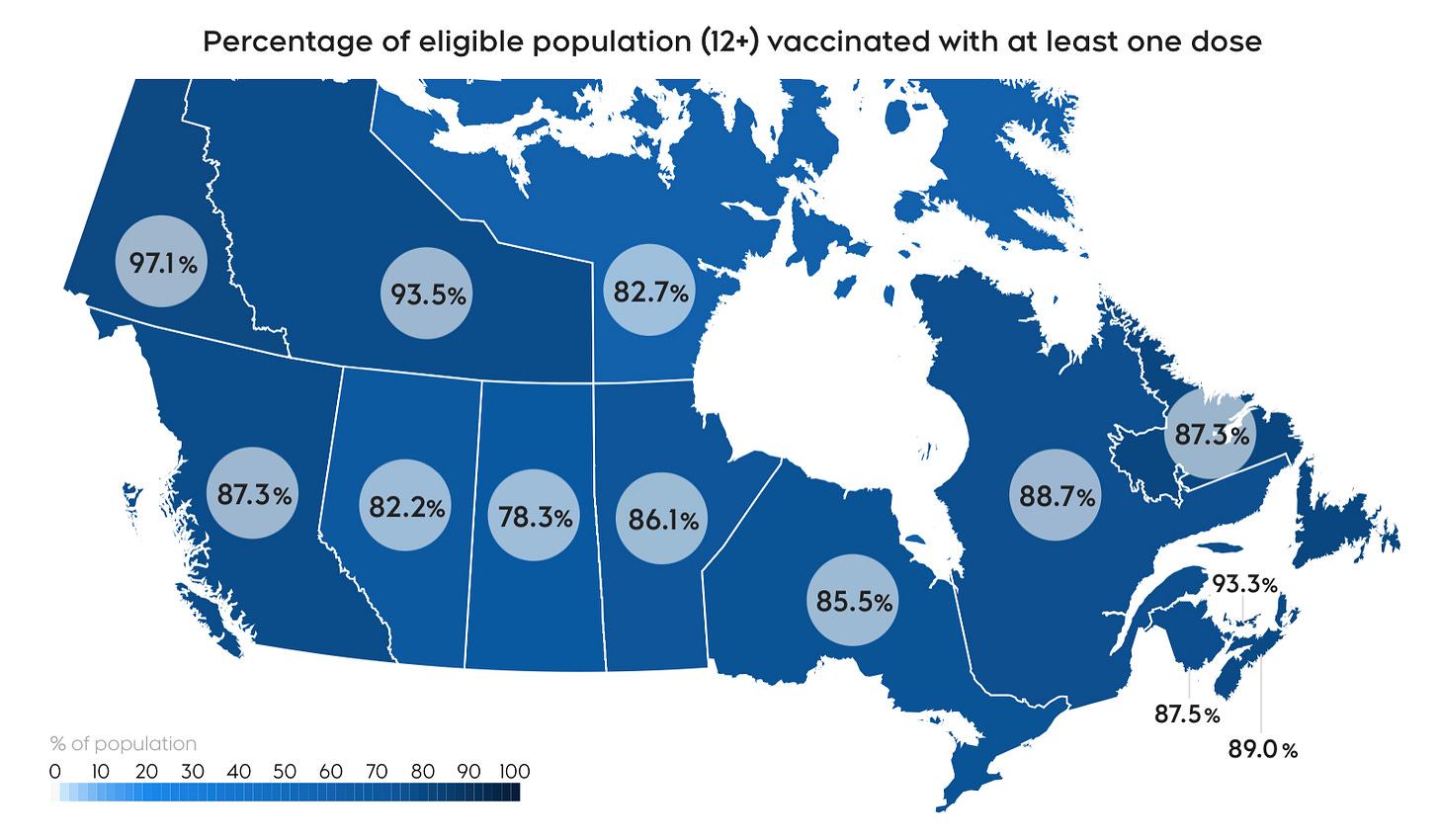The Evening Report - Sept 23
Viral infections other than COVID remain a major concern in Denmark
Informeret Note
Updates will be a little sporadic over the next two weeks. My son and I traveled from Denmark to Canada to surprise my parents. You can see how that went below.

🇩🇰
A new risk assessment from the Staten Serum Institut says while the RS virus infection wave “is in full swing” there has been a “small drop” in activity in the past week. The agency says this could indicate virus activity may be ebbing. That said, the SSI cautions the epidemic “may last for weeks, yet.”
In week 36 alone, there were over 1,300 RS virus infections followed by over 1,100 in week 37. In both cases, those numbers are three to four times higher than anything seen before in Denmark, when the virus season usually peaks in February. The usual RS virus season runs from December to March.
Ward Doctor Lasse Vestergaard calls the explosion of RS virus infections a situation without precedent.
“In the past week, we have seen a small decrease in the otherwise sharply upward infection curve. This indicates a slowdown in the development of infection, but the unusual and high spread of infection with the RS virus will probably continue for a while yet. Outbreaks of the RS virus we typically experience in the winter months, and we therefore also expect that the epidemic this year will last longer than the normal 6-10 weeks due to the early start. How long the epidemic will last and whether we will see repeated waves of infection through the autumn and winter is difficult to predict.”
The Institut remains worried that with the upcoming influenza season, potential continued RS virus infections, and COVID still circulating that “could challenge health care in the coming months.”
Another continuing concern is that because of RS virus infections exploding far earlier than ever seen before, testing for it remains lower than if it were in the normal winter outbreak period. It says “this suggests that there is widespread RS virus infection in the community.”
The SSI continues to warn that due to the pandemic, natural immunity, especially in young children, has been impacted, which could mean the usual viruses will come roaring back.
“We are in a somewhat unfamiliar territory with this unusual development of infection activity, which we believe may be related to the fact that the youngest children have not developed sufficient immunity, after a winter where we had virtually no RS virus due to COVID restrictions.”
Usually the RS virus hits the youngest children, just one or two years old, the hardest, but it adds it is now seeing infections roar through older kids aged 2 to 4 years old. The SSI says this is being seen with “many hospitalized children with the RS virus are currently being reported from the country's pediatric wards.”
-
The Staten Serum Institut has clarified with DR that while a massive flu shot campaign will begin October 1, the first doses of the vaccine for young children won’t arrive until week 40.
For the first time ever, Denmark is opening up influenza vaccinations to children aged two to six years old. Instead of a shot, young children will have to take their vaccination via a nasal spray.
The SSI says the first of the nasal spray vaccine doses won’t arrive until October 4 at the earliest.
More details of how vaccinations will be administered and who will administer them are expected to be rolled out next week by the Danish health ministry.
-
For a seventh week, the Delta variant was absolutely dominant in Denmark with no other variants of concern detected. Since last week’s variant update, the Staten Serum Institut says they have registered another 979 Delta variant infections.
The Delta strain registered as the variant responsible for 99.8% of all sequenced positive test results over the last week. It has totally wiped out the Alpha variant in Denmark, a feat it accomplished in a little over three months.
-
On the vaccination front to date, 75.9% of the total population has one vaccine dose and 74.2% are fully vaccinated. The gap between 1st and 2nd doses is now just 99,535.
Yesterday there were 5,189 total inoculations, of which 1,334 were 1st doses.
-
The Danish Health and Medicines Data Authority says it has fixed an issue with the coronapas impacting people who have had booster shots. Sundhedsdatastyrelsen Director Lisbeth Nielsen says the digital vaccine passport now displays the third dose and restores the full vaccination status.
Previously, once the third dose was imputed into the system, the first dose vanished. For those who were traveling, it created a headache as their coronapas registered them as not fully vaccinated in the two week period from their third booster dose.
-
Denmark is reporting 341 COVID infections and four more coronavirus deaths in the last day. Yesterday there were 346 infections and one more fatality.
Yesterday there was 77,009 corona tests done, 48,162 PCR and 28,847 rapid, for a (PCR only) positivity percentage of 0.70%.
-
COVID hospitalizations (87) continued to drop (-2) while the number of infected in an ICU (18) also dropped (-4) and of those the number on a ventilator (13) declined as well (-3).
Over the last seven days there have been three children 11 years old and under hospitalized due to COVID, but the age group seeing the most admissions are those aged 40 to 79 years old.
-
The Staten Serum Institut says its COVID wastewater monitoring program is working out really well, but some wrinkles continue to need to be ironed out. The wastewater monitoring program has gone from trial runs in several locations to being officially set up in 16 wastewater sites across the country before it was expanded to 50.
Section Manager Steen Ethelberg says the program will grow even further.
“The national monitoring of SARS-CoV-2 in wastewater continues. During the coming month, it will be scaled up to cover more than 200 treatment plants and pumping stations, thereby covering the majority of Danish households.”
The latest report cites a regular testing connection between positive results in wastewater testing and a flaring up of infections among the population. One of the biggest successes was in Skagen, where wastewater testing showed a spike in infection activity before an actual outbreak showed up in testing of people.
However, in other areas there were increases in wastewater testing results and no associated surge in associated communities. The Institut says the testing methods must continue to be worked on and refined.
-
The Danish National Association of Local Authorities has reached an agreement with the government and the five different regions on COVID testing for employees in nursing and senior care homes. Fully vaccinated senior care employees will be tested once a week, while the few who are not vaccinated must get COVID tested twice a week.
🇸🇪
Sweden added 1,673 infections and and another 23 corona deaths in the last 48 hours.
To date, 7,115,096 1st doses (83.3% of the population 16 years old and older) and 6,452,711 (75.5%) 2nd vaccine doses have been administered.
-
Sweden’s capital region is cautiously optimistic that the worst of this latest infection wave might now be behind them. Region Stockholm says 1,754 coronavirus cases were confirmed in week 37, which is 437 fewer cases than the week before. There were also 107 infected people in hospital last week, which is also fewer admissions than seen the week prior.
Acting Health and Medical Care Director Johan Bratt says this is good news, but he advises caution.
“We should wait before we draw any conclusions about it as the number of COVID tests administered also decreased sharply during the past week. At the same time, we note that vaccinations are increasing, but still at too low a rate for us to be completely satisfied. Many restrictions will be removed next Wednesday; until then we must increase the number of vaccinated even further.”
The region is pulling out the stops to get vaccination rates up. Efforts include removing the need to book appointments, increasing drop-in sites, and using more mobile pop-up sites.
The region also warns there is a significant backlog in reporting COVID deaths. Currently, backlogs are over a month behind.
-
Region Stockholm is going mobile with its COVID testing efforts. The first of four testing buses swung into operation today and three more will soon follow. The mobile testing sites will operate between 9:00am and 4:00pm. The buses will be staffed with multi-lingual staff who can administer COVID tests without the need for an appointment. All people need to do is bring their identification.
-
In Southern Sweden Region Skåne will begin vaccinating children aged 12 to 15 years old as of October 11. While planning is still underway, the region says the vaccination effort will be done in schools.
Vaccine Coordinator Maria Landgren:
“We are striving for high vaccination coverage in this group and we know that the schools are the best place to get the vaccinations done. We want to use schools' existing routines for childhood vaccinations as much as possible.”
Children will be given one vaccine dose and then a second six weeks after the first.
🇳🇴
Norway has added 1,540 infections and another nine virus deaths in the last two days.
COVID hospitalizations (100) have dropped (-19) ICU numbers (33) are also down (-2) and of those entilator numbers (18) are unchanged.
To date, 76.17% of Norwegians have had one vaccine dose and 66.54% have had both
-
After seeing record high numbers of daily infections, Norway is seeing its latest Delta variant-driven infections wave ease. The Norwegian Institute of Public Health says the number of infections and hospitalizations both declined last week compared to the week before. Among last week’s hospital admissions, 55% were unvaccinated, 5% had just one dose, and 41% were fully vaccinated. The health agency attributes this to a very high vaccination rate in Norway and the Delta variant, which is punching through much more than any other previous variant.
When the 4th wave struck in mid-August Norway saw infections rise mostly among young people between six to 25 years old. The institute notes that trend is now reversing with cases in the age group “declining rapidly.”
The NIPH is estimating that infection activity will stabilize at low levels over the next few weeks, but “there is considerable uncertainty about development through the winter”. It recommends the vaccination campaign continue “with full force” and everyone be prepared for infection activity to rise again through the fall and winter.
-
The Norwegian Institute of Public Health is using population-level surveys to investigate if there is any connection between COVID vaccines and reports of menstrual issues among some women.
Project Manager Dr. Lill Trogstad:
“At present, we do not know for sure whether menstrual disorders or abdominal bleeding after menopause occur more frequently after vaccination than normal. This is important to find out and we are now working to acquire knowledge about this.”
The surveys will ask questions about any menstrual disorders among young women and bleeding issues after menopause for older women.
“Even though we ask many questions about different symptoms, it does not mean that we think the vaccines are to blame. There is generally little knowledge about how common or unusual bleeding disorders are in women of different ages. Therefore, we now ask to find out more.”
-
Healthcare employees in Norway continue to boast vaccination rates higher than the general population. The Norwegian Institute of Public Health says the overall vaccination rate for approximately 350,000 people is 92% compared to 88.6% for the rest of the population as of September 5.
Health Service Research and Analyst Kristian Bandlien Kraft:
“These are gratifying figures for vaccine coverage in Norway, and show that employees in the health service have a high degree of confidence in the vaccination program. It also shows that the vast majority have taken the opportunity to get vaccinated.”
The institute did a deep dive into vaccination data for healthcare workers and found that those born in Vietnam, Thailand, Sri Lanka, and Denmark have vaccination coverage of 95% or more. While those born in Russia, Serbia, Lithuania, Romania, Poland, Eritrea, and Somalia have the lowest rates, between 70% to 80%.
There are also differences between occupational groups, with doctors and specialist nurses having 97% vaccine coverage while nursing staff have 89%. The only occupational group with lower coverage is cleaning staff.
“We do not know what the reason is for the differences, but one possibility may be around who was offered the vaccine first. Among other things, 73% and 76% of nursing staff in primary and specialist health services, respectively, have received two doses.”
The institute recommends focusing efforts on cleaning staff to get vaccinate rates up.
🇫🇮
In the last two days Finland has reported 951 infections.
In its major Wednesday update, it registered 11 corona deaths over the previous seven days.
So far, 4,113,377 1st doses (73.4% of the total population) and 3,326,574 2nd vaccine doses (59.6%) have been administered
-
Finland is beginning a booster dose campaign. The Finnish Institute for Health has officially recommended the different health agencies to begin administering a third vaccine dose to anyone 12 years old and older who is immunocompromised.
Chief Physician Hanna Nohynek:
“According to research, two vaccine doses are not enough to protect people with severe immune deficiency against coronavirus, so three doses is recommended for them. For most people with immune deficiency, a third dose raises the protection provided by the basic vaccination series to an adequate level.”
The third dose will be administered two months after the second. The health agency says vaccine supplies are in good shape and allow for the booster shot effort to begin immediately.
The agency says it will also issue a decision soon on offering booster shots to healthcare workers and senior home staff.
🇩🇪
Germany is beginning to get tougher on people who refuse to get vaccinated. Authorities in Germany have decided as of November 1 people who are unvaccinated will not be compensated for lost wages due to any coronavirus quarantines. There will be exemptions for those who for medical reasons cannot get vaccinated. The new measure would include unvaccinated people returning from trips abroad from high-risk countries who would be required to isolate on arrival. Until now, the state has provided compensation to workers who have lost wages due to COVID infections and quarantines.
The country has also followed through on another threat to end free COVID testing. As of October 11, access to free COVID testing will end for just about everyone in the country. Only young children and those who for medical reasons cannot get vaccinated will be able to get tested for free. Everyone else will now have to pay to get a COVID test. Some people have been choosing not to get vaccinated and have been going to bars, out to eat, and attending sports activities by using a recent negative test. The thought from German authorities is the inconvenience of having to now pay for COVID testing will compel people to get vaccinated instead.
🇪🇺
The European Medicines Agency says it is evaluating an application from Pfizer/BioNTech for approval to authorize booster doses for everyone over the age of 16. If approved, the third shot would be given six months after the first. The EMA says it will announce a decision in October.
The EMA also revealed it has not yet received any applications for COVID vaccines to be extended to children under the age of 12. It says it expects Pfizer/BioNTech to submit such an application for approval to use its vaccine for children aged 5 to 11 in early November.
🇺🇸
The United States will double its donation of vaccine doses to developing countries. The news was announced this week by President Joe Biden, who said an additional 500 million vaccine doses will be donated, pushing its total commitment to one billion doses.
While this is welcome news, the World Health Organization continues to stress the need far outweighs the supply. It says even with increased American donations the need on the ground in the world’s poorest countries is “at least eleven times greater.”
🇨🇦
Canada reported 3,882 infections and another 49 deaths as of September 22.
On the vaccination front to date, 28,812,222 1st vaccine doses (75.68% of the total population) have been administered while 26,574,513 people (69.80%) have been fully vaccinated.
In Ontario today, 677 new infections, of which 529 were among people either unvaccinated or having a single dose. There are 307 people in hospital and of those 273 are unvaccinated or have just one dose. In ICUs there are 193 people with the number of unvaccinated or partially vaccinated being 181.
Quebec reported 754 infections and seven more deaths.
In Atlantic Canada, New Brunswick recorded 52 infections. Nova Scotia saw 41 infections and one more death. Newfoundland and Labrador had 23.
Manitoba saw 67 new COVID cases
There were in 460 infections and seven deaths in Saskatchewan today. Of those, 111 corona cases were among children 11 years old and under.
Alberta recorded 1,660 new infections with 17 more deaths on Thursday. The province has a positivity percentage of 9.4%. There are 1,058 people in hospital and of those 226 are in an ICU. Every single person in intensive care is unvaccinated, all of them.
B.C. logged 861 infections and five more deaths today.








